
Asset Management Manual
A guide for practitioners!

Asset Management Manual
A guide for practitioners!
Overall structure
An asset management tool supports the implementation of the asset management framework by performing the following main functions:
Each of these functions is developed to a greater or lesser extent depending on the maturity level of the organization implementing the asset management procedures, as described below.
Note that although data collection and processing is an important and difficult phase in road asset management, it is often considered as a separate task, either performed with specific devices by contractors (road condition indicators) or resulting from a careful review of an organization’s archives (road structure, maintenance works…). This is discussed in more detail in section 2.1 of this guide.
The main functions of an AMT for organizations at a basic maturity level are as follows:
Calculation of KPIs at a given time, which corresponds to the time when the data were collected (year n). At the basic maturity level, the technical KPIs are mainly structural and surface ratings.
Development of maintenance programs (type, priority, and ultimately a list of actions) and allocation of resources based on predefined strategies. Because no deterioration models are involved at this level, medium- and long-term performances and programs cannot be assessed. Accordingly, the outcome consists of an annual (year n+1), biannual (years n+1 and n+2), or at most triennial (years n+1, n+2, and n+3) program. This function is realized in three steps: identification, prioritization, and allocation of maintenance needs (to year 1, 2, or 3). The basic assumption made in this module is that the maintenance and rehabilitation needs defined on the basis of data collected at year n will remain adequate even if they are applied in years n+2 or n+3, which often is not fully satisfying.
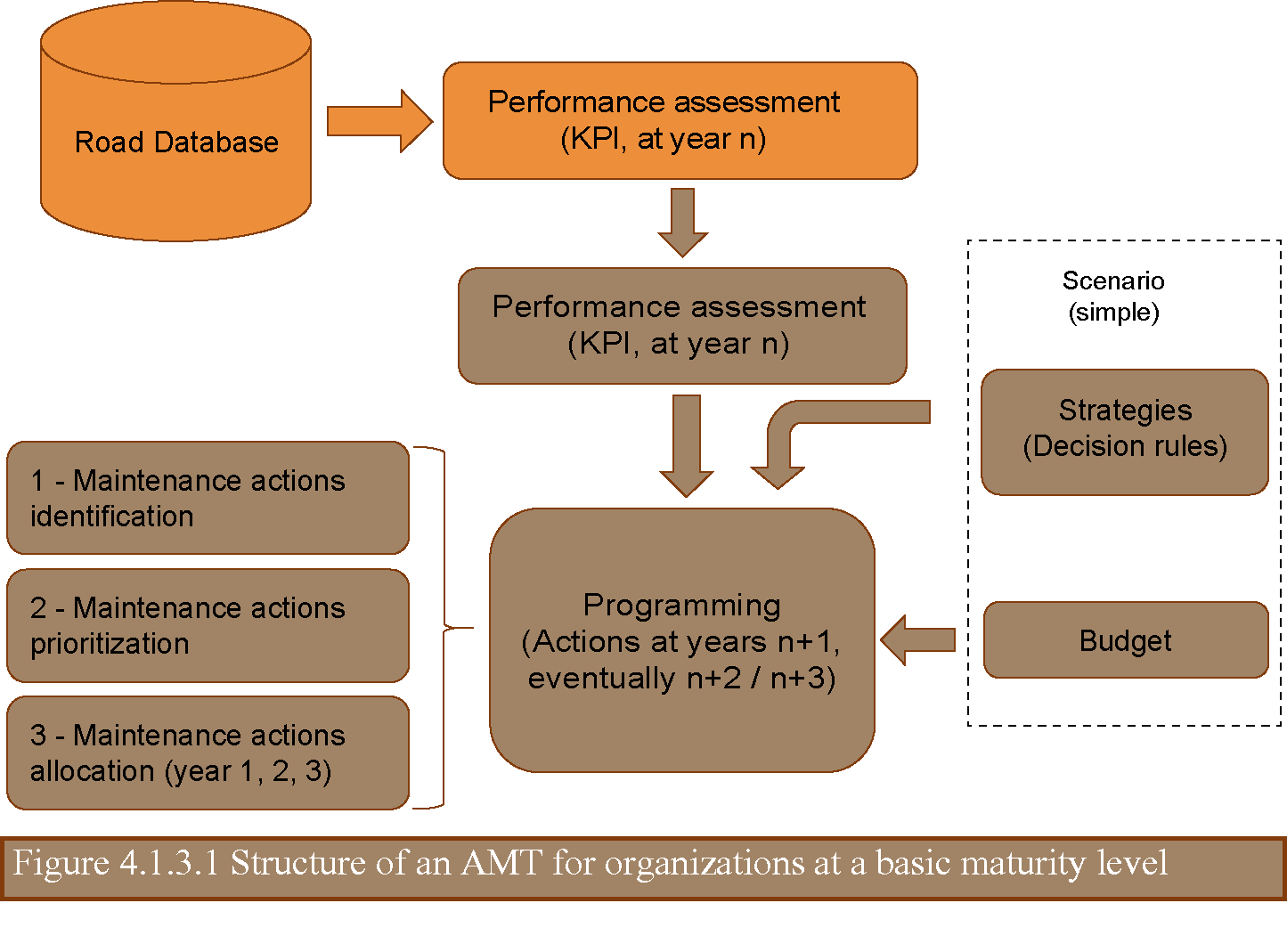
According to the approach developed in this guide, the AMT for organizations at a proficient maturity level should include greater functionality than that for organizations at the basic level. The greater functionality is as follows:
Deterioration models: Deterioration models are calculated and applied. These models mainly include distress evolution models and some physical characteristics evolution models (deflection, texture, skid resistance, etc.). With these models, the AMT can be used to simulate different scenarios in the medium and long terms. The set of condition indicator evolution models includes two types of models:
Natural evolution models (NEMs): These models quantify the variation of condition indicator values over time due to climate and traffic when no intervention is applied.
Intervention effect models (IEMs): The maintenance and rehabilitation interventions obviously have some effects on the condition indicators, which reflect the effects the interventions have on the asset. These effects are specified in the intervention effect models.Figure 4.1.3.2 illustrates such models.
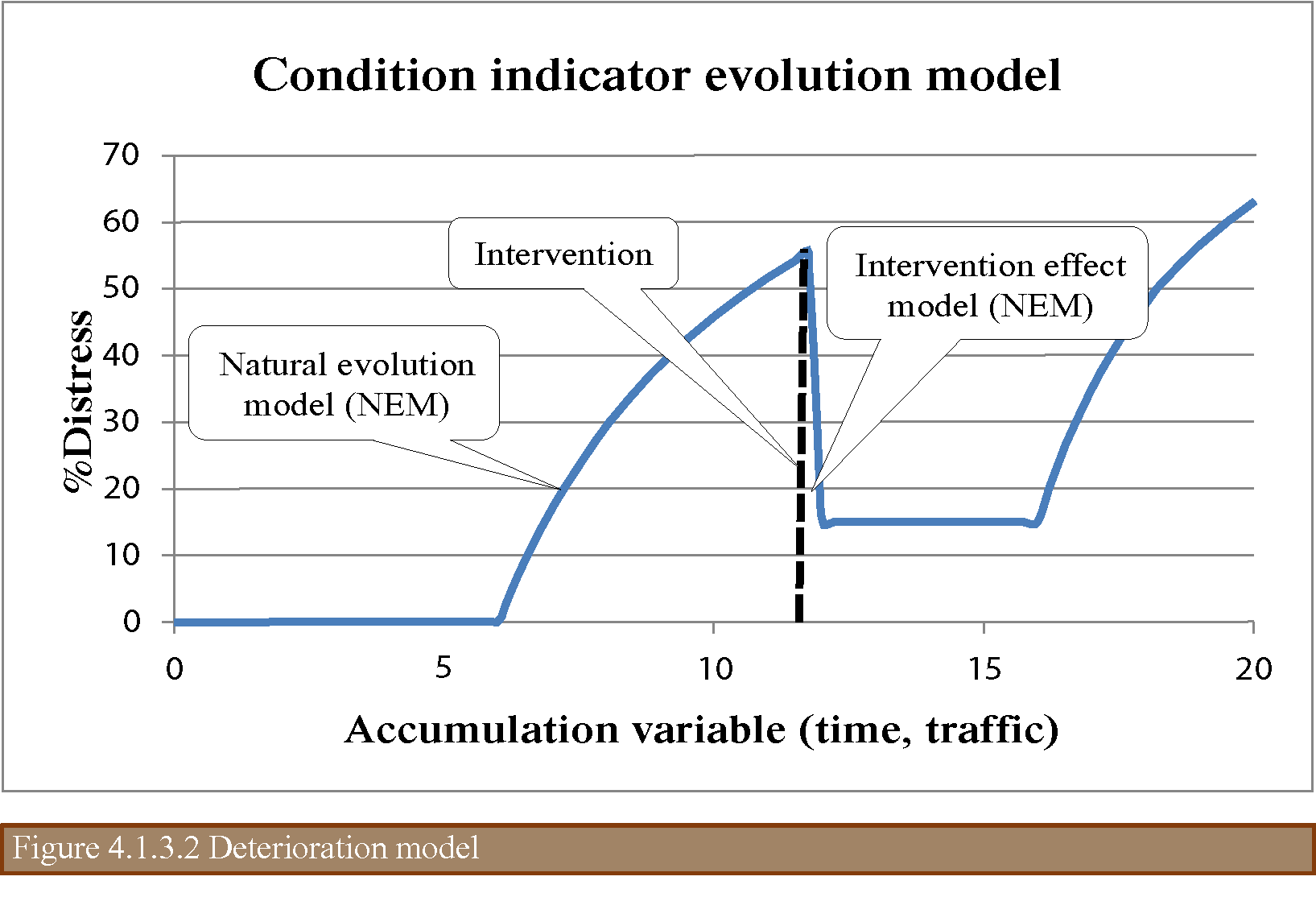
Performance assessment: The performance module is expanded to take into account more detailed data and deterioration models and calculate costs and benefits using socioeconomic and environmental KPIs. Including GRC and DRC in the calculation of asset values is one of the supplementary performance indicators. (Refer to section 3.3 of this guide.)
Note that a performance modeling module involves one or two sub-functions (Figure 4.1.3.3):
Minimally, application of condition indicator evolution models (NEM, IEM) to actual data in order to simulate the aging process of the network. This sub-function is necessary to perform medium- and long-term simulations.
Optionally, identification of these condition indicator evolution models from the data collected on the network during previous surveys and stored in the road database. Note that these models can be derived from external studies too, but not as well.
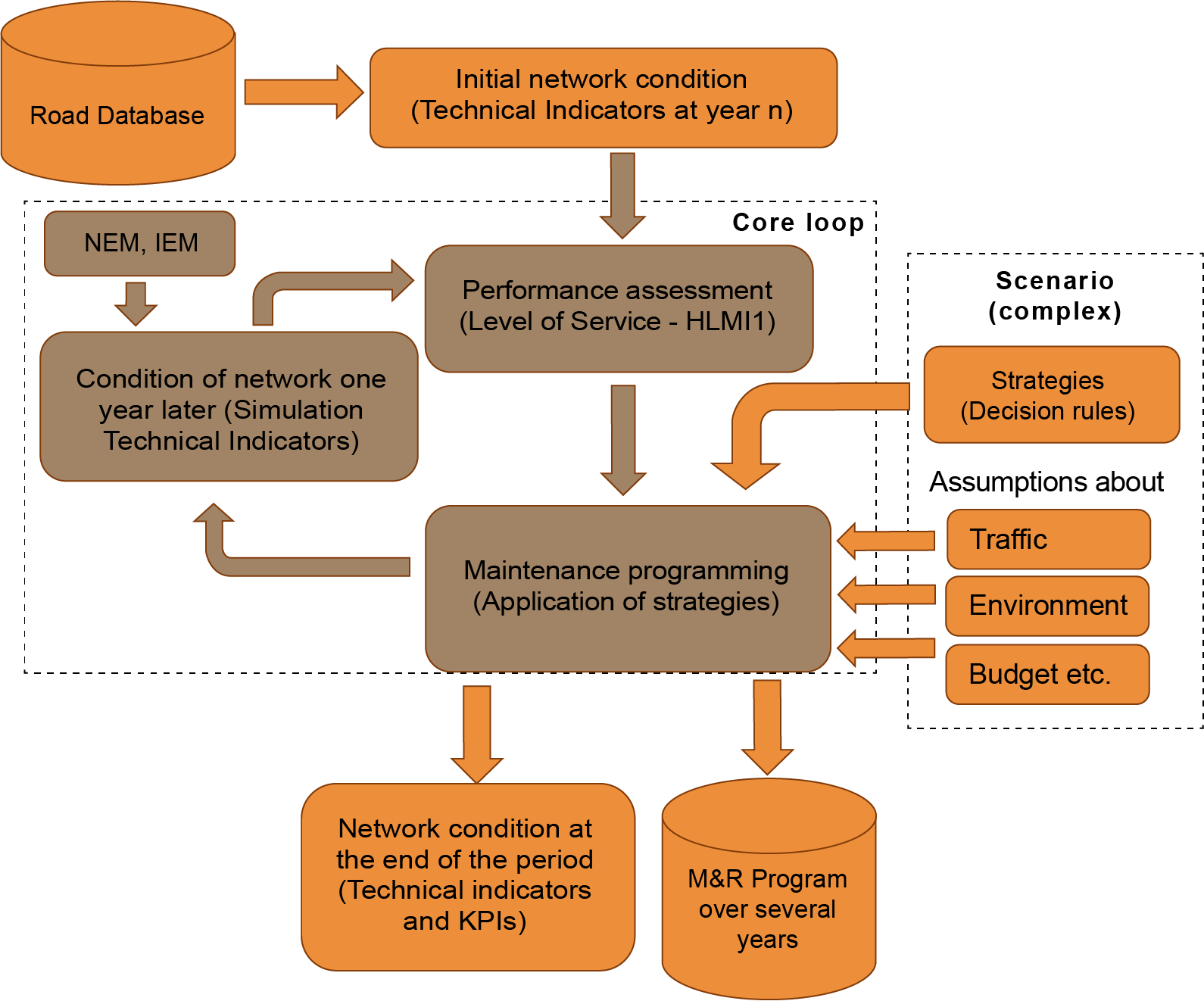
Multi-annual maintenance programming: Given the condition of the network in a certain year, the asset management strategies, and the annual budget (which may vary over time), the module should be able to simulate different scenarios over the medium and long terms.
Cost-benefit analysis (CBA): Basically, CBA balances the total costs of maintenance to prevent asset deterioration (treatment costs, road organization costs, extra costs for work areas, costs of negative environmental impacts in the short term, etc.) and the total benefits produced by maintenance (medium- and long-term positive impacts on the economy, society, and the environment) in the same period. This balance has meaning only when calculated based on the lifecycle of the asset components. The lifecycle is the period between two major asset component reconstructions. Performing CBA implies that the previous AMT structure needs to be enlarged to take into account the various impacts of asset management. Different modules should be added to the structure, as shown in Figure 4.1.3.3.
Assessment of all costs caused by intervention on the asset, such as the direct works costs, the indirect work costs, the costs of traffic management during the interventions (detours, signs, etc.), the costs to the users during the intervention (extra delays and fuel consumption caused by congestion), etc. Specific models may be required to evaluate these costs, for instance the costs of congestion during the intervention, which depend on the traffic signature, or the costs of the reduction in flow capacity.
Assessment of all benefits resulting from intervention, such as reduced travel times, vehicle operating costs, traffic risk, etc. Again, specific models must be added to the structure illustrated in Figure 4.1.3.3 to perform these assessments.
Finally, the complete structure is shown in Figure 4.1.3.4.
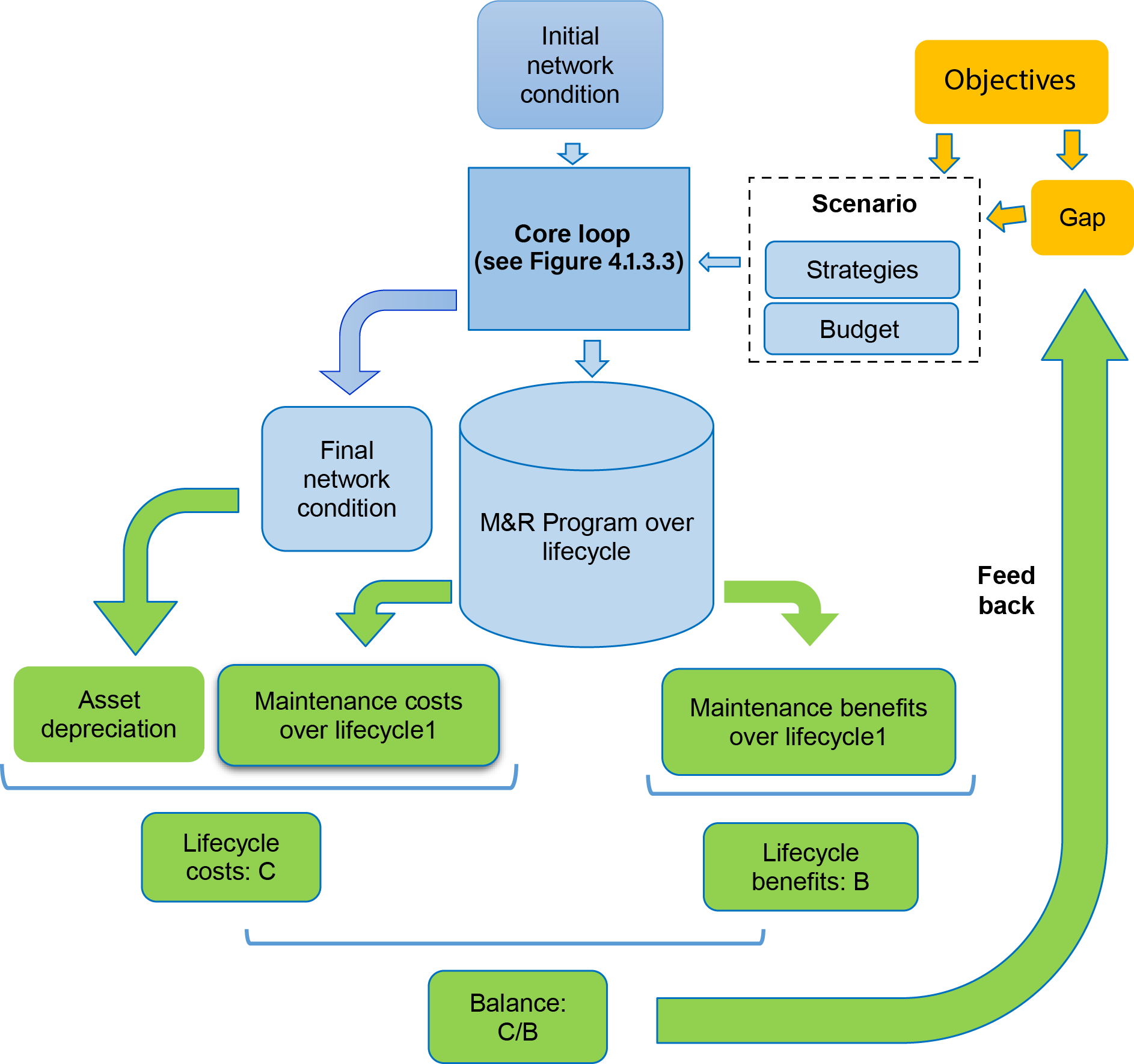
The result of the CBA is affected by a number of issues. There may be uncertainties, such as traffic demand and growth, that affect asset performance, particularly as a result of the climatic region. Accordingly, CBA cannot deliver exact and definitive answers. A risk analysis must therefore be conducted to quantify the reliability of these conclusions.
Risk analysis: Risk analysis does not need a specific or additional module. It is conducted by iterating the simulation through a number of scenarios according to the structure illustrated in Figure 4.1.3.3 with each scenario assigned a specific probability or distribution of probability (of traffic growth, budget reduction, occurrence of an environmental event, modification of regulations or laws, etc.). The realism of the risk considered in the analysis is decided by an experienced user. The results of the different runs are weighted by the probability of the simulated scenario occurring. The strategies that are finally fixed are those that realize the accepted risk for the road organization.
Financial plan: As with risk analysis, this function does not require a specific module. It is performed by well-organized and coordinated applications of the structure illustrated in Figure 4.1.3.3. Two sets of applications are required to build a rational and consistent financial plan:
Simulation of past strategies, in which the AMT is used to find the strategy that is consistent with the recent evolution of the network condition, given the external factors affecting the network (traffic variation, climate events, geologic events, etc.) and the budget.
Selection of future budget and strategies and, consequently, simulation of realistic scenarios, which will ultimately provide information on the best schema of budget allocation.
An AMT for organizations at this maturity level requires at least three additional functions:
Investment strategies: Beyond the maintenance policy, the most significant problem that any road organization deals with includes evaluating how much of the budget should be invested in the road to secure its value and services. Using the system illustrated in Figure 4.1.3.4 may be sufficient to answer this question. No additional software module is required to perform this function.
Asset management plan: Once the CBA and risk analysis are performed with the help of the system illustrated in Figure 4.1.3.4 the asset management plan can be finalized. No additional software module is required to perform this function.
Performance monitoring: Once the annual maintenance program has been carried out on the whole asset, the KPIs can be recalculated either from collecting new on-site data for the whole or a part of the network or from applying condition indicator evolution models. The Performance Modelling module is available to perform this updating of the overall assessment of the asset. No additional software module is required to perform this function.
Requirements for an AMT are summarized in table 4.1.3
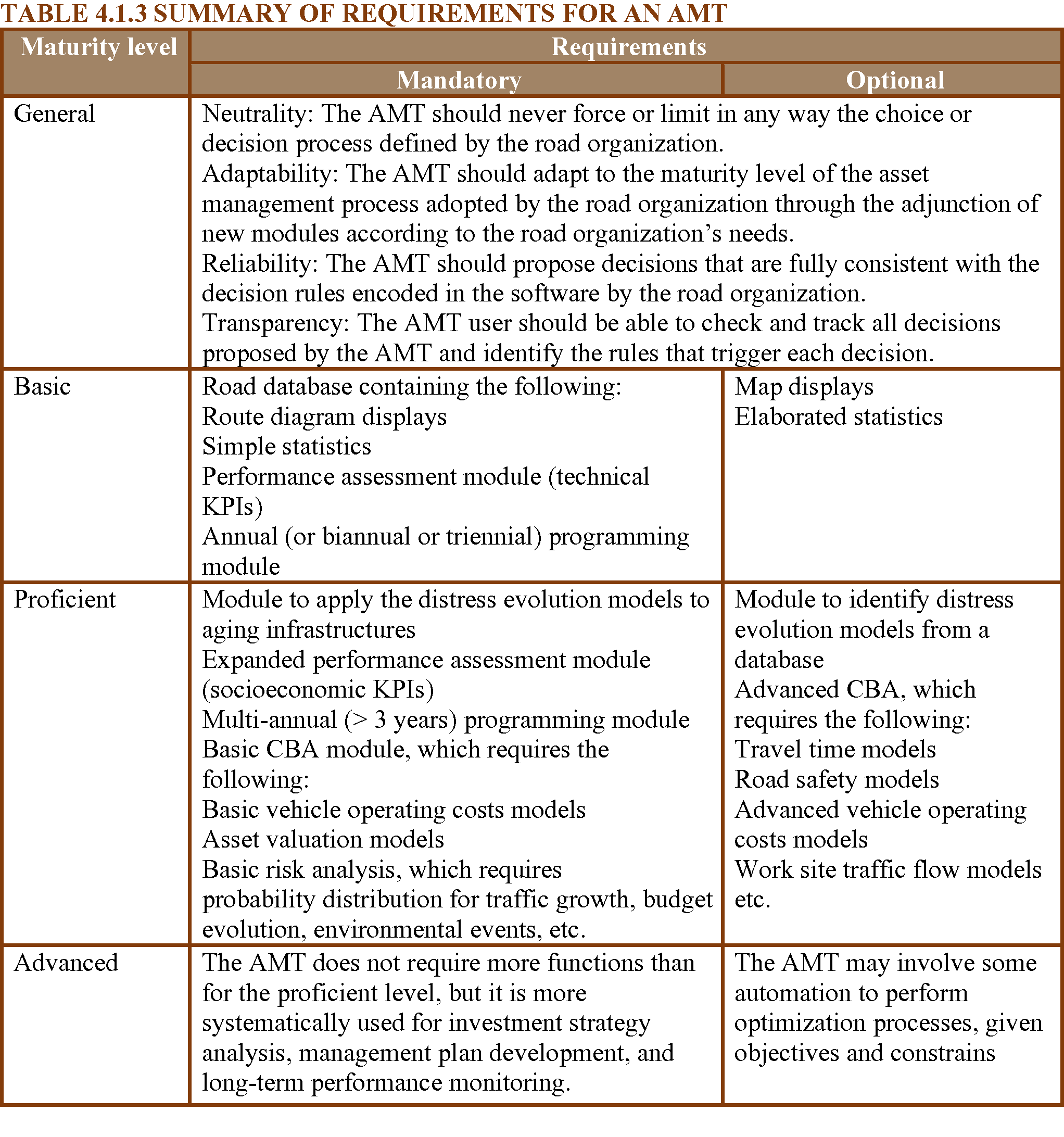
Note that the same AMT should be applicable for organizations at the basic to the advanced maturity level, which means that it should potentially meet all the requirements. However, the operating system needs only to meet the requirements applicable to the maturity level of the asset management process at a given time.